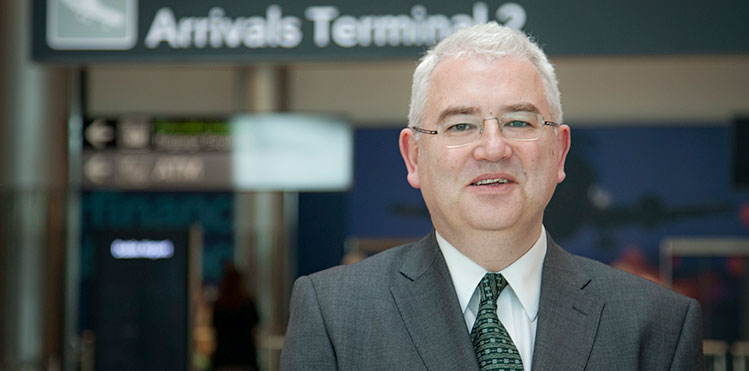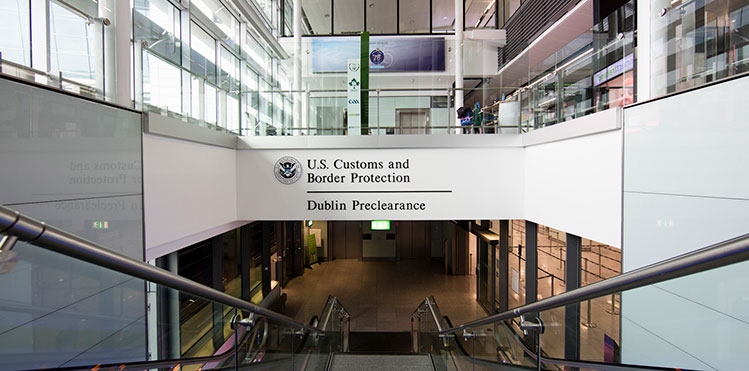Vincent Harrison, Managing Director, Dublin Airport, briefs Marta Dimitrova on the airport’s progressive transatlantic route development strategy and strong passenger growth, while maintaining the airport’s focus on customer service.

Vincent Harrison, Managing Director, Dublin Airport: “Long-haul has been, and continues to be a key area of growth for the business. One of our aims is to grow connectivity for the benefit of the Irish economy and more direct long-haul routes have a huge role to play in this area in terms of boosting tourism, trade and foreign direct investment.”
Over the past decade, Dublin has rapidly transformed into a hub for tech companies including the likes of Google, Facebook, Linkedin and Twitter, turning its industrial-looking docklands into what is now known as ‘Silicon Docks’ – the Irish equivalent of Silicon Valley. This combined with the city’s cobbled streets and local pubs, makes the city an attractive all-year-round destination for both leisure and business tourists.
Dublin Airport welcomed 20 million passengers in the first eight months of 2017, marking a 6% increase compared to last year.
“We have seen growth across almost all sectors of the business this year,” enthuses Vincent Harrison, Managing Director, Dublin Airport. “We’ve had four new long-haul routes to North America and a new long-haul service to the Middle East, as well as seven new short-haul services.”
The airport welcomed Qatar Airways to the Irish market in June with a new Dublin-Doha service and Air Arabia Maroc will be launching a new route to Agadir in Morocco in October. Moreover, Norwegian launched its first two transatlantic services from Dublin this year, while Aer Lingus added a new destination to Miami, and Delta has opened a Boston service.
“The combination of these new services and the full-year impact of last year’s transatlantic capacity expansion is fuelling strong double-digit growth of our North American business in 2017. We’re also continuing to see strong growth in transfer traffic as Dublin expands its position as a key gateway between Europe and North America.”
With the newly-launched services to Boston and Miami, Dublin is now the fifth largest airport in Europe for transatlantic connectivity after Heathrow, Schiphol, Frankfurt and Paris Charles de Gaulle airports. “This is now a significant part of our business. About one in five transatlantic passengers using Dublin don’t begin or end their journey at Dublin and this transfer traffic underpins the viability of new routes and route expansions on transatlantic services.”
Dublin is also the only capital city airport in Europe with US preclearance facilities and Harrison explains that travellers find it extremely convenient to arrive in the US as a domestic passenger, making connections easier and allowing for seamless onward travel to their final destination.
In contrast to the increasing transatlantic growth, Harrison shares that UK originating traffic to Dublin is down about 6% following the fall in value of Sterling, while Ireland-UK traffic flows are flat overall due to an increase in Irish originating passengers.

With the newly-launched services to Boston and Miami, Dublin is now the fifth largest airport in Europe for transatlantic connectivity after Heathrow, Schiphol, Frankfurt and Paris Charles de Gaulle airports. It is also the only capital city airport in Europe with US preclearance facilities, making connections easier and allowing for seamless onward travel.
More direct long-haul routes
“Long-haul has been, and continues to be a key area of growth for the business. One of our aims is to grow connectivity for the benefit of the Irish economy and more direct long-haul routes have a huge role to play in this area in terms of boosting tourism, trade and foreign direct investment.”
Indeed, the airport has already secured new routes for 2018, including four-times weekly service between Dublin and Montréal. Harrison comments: “This new route will offer further choice for passengers and continue to expand our Canadian business. A decade ago, Dublin had 38,000 passengers travelling between Ireland and Toronto. This year we’ll have about 340,000 passengers on flights between Dublin and five Canadian destinations – Toronto, Montréal, Halifax, Vancouver and St John’s. There are huge business and cultural connections between the two countries and this further expansion by Air Canada is excellent news for Dublin Airport.”
Furthermore, the airport is looking forward to adding long-haul destinations both to the West and East. “We believe there is a strong demand for extra North American destinations. We recently announced Hong Kong with Cathay Pacific next June, and we’ve also made no secret of our desire for a service to mainland China. We are also looking at European destinations that we don’t currently serve.”
With such a progressive route development strategy, naturally, passenger numbers at the airport are growing rapidly. However, despite the 51% passenger growth since 2010, Dublin Airport has consistently improved its customer service scores in the global Airport Service Quality (ASQ) rankings and has maintained a top five position within Europe since 2013. In 2015, Dublin Airport was rated the best in Europe for customer service within the ACI EUROPE rankings, while last year it was Europe’s joint third best airport for customer service.
“We continue to be focused on improving the product for customers and airlines and are currently investing €100 million per year on new and improved facilities. We use the feedback from our Happy or Not machines to assess our performance on a real-time basis to allow us to make improvements quickly if required and to spot trends on a long-term basis.”
To respond to the constant passenger growth, Dublin Airport is currently working on the construction of a new runway, scheduled to be complete in 2021. Looking ahead, Harrison concludes: “The runway has the potential to open up connectivity to more challenging parts of our target markets, such as Southeast Asia, South America and Southern Africa.”







